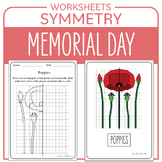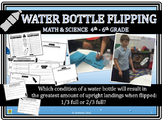39 results
High school calculus lessons for Easel Activities

Precalculus Summer Review Packet
Use this Precalculus Summer Review Packet to assess the prerequisite skills your students have and determine what skills need remediation. Through this precalculus packet, students will review their mathematics before you teach them new material. Check out the Precalculus Summer Review Packet Feedback: "This is one of the best most comprehensive review activities to begin the school year! My students could determine their strengths and weaknesses so quickly and easily! They knew what remedial qu
Subjects:
Grades:
9th - 12th
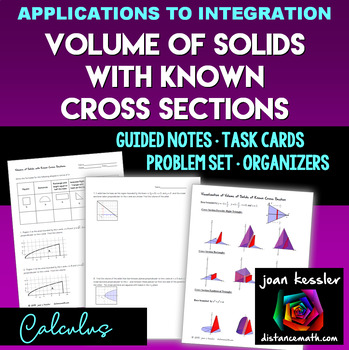
Calculus Volume of Solids Known Cross Sections Notes Organizer
This lesson on Volume of Solids of Known Cross Section is designed for AP Calculus AB, BC or College Calculus 2. It is from the Applications of Integration Unit. Included: Guided notes and examples on Volumes Solids of Known Cross Sections, with a Warm-up section. Included are eight problems and FULL Solutions. Eight Task Cards which include varying (and different from above) problems. Cross sections include circles, triangles and rectangles with both x and y perpendicular sections. I have in
Subjects:
Grades:
10th - 12th, Higher Education
Also included in: Calculus Bundle of 15 Activities and Resources

Limits from Tables for Calculus
This Evaluating Limits from Tables activity is designed to help Calculus students understand and master the concepts in this section and promote fluency. What's Included?11 Task cards which include polynomial, rational, irrational, and trig functions. Students use a table to determine if a limit exists and to evaluate it, if it exists. There are also problems which students are given a table and asked to estimate the limit. Blank Task card for you to personalizeAnswer keys and student response
Subjects:
Grades:
10th - 12th, Higher Education
Types:
Also included in: Limits and Continuity Calculus Unit 1 Bundle
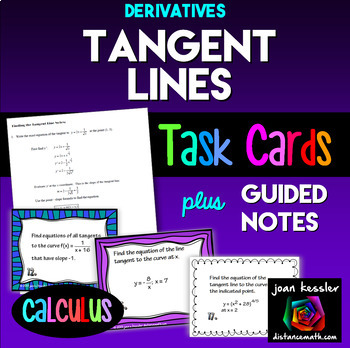
Derivatives Equations of Tangents Lines Task Cards and Guided Notes
This finding the Equation of the Tangent Line, both before and after the Chain Rule will get your Calculus students engaged and keep them motivated to go through all of the problems, more so than a simple worksheet. What's Included?Step by Step Guided Notes24 Task cards: # 1 - 11 can be done early in the topic, using the limit definition or the rules of derivatives before Trig and the Chain Rule. Cards #12 - 24 use the Quotient Rule, Trig, Logs, and Exponentials. This gives you lots of differe
Grades:
10th - 12th, Higher Education
Types:
Also included in: Calculus Derivatives Differentiation Units Bundle
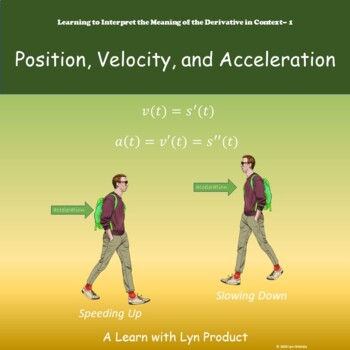
Position, Velocity, and Acceleration
The no prep lesson and worksheet are easy for students to follow and complete. Students will learn step-by-step how to find velocity and acceleration at a point, and then determine if an object is speeding up or slowing down. You can print this lesson and use it as an in-class activity or download the digital learning choice for distance learning students. Even if you have a hybrid class, both types of students can access this lesson. Also, this can be used for students who were absent when the
Grades:
10th - 12th
Types:

Instantaneous Rate of Change - Day 1 of a Jet Tour of Calculus
What is in the lesson-activity?The lesson-activity is made up of a 40-50 minute activity and a 2-page homework assignment with two questions similar to those in the activity. Answers to the lesson-activity and the homework assignment are included.Instantaneous Rate of Change, introduces the concept that average rates of change can lead to finding the instantaneous rate of change by making the change in x smaller and smaller. A real world problem about the height of a homemade rocket, after it
Grades:
11th - 12th
Types:
Also included in: Jet Tour of Calculus - Five Days of Lessons - Bundled

Lesson: Concavity, Inflection Points, and the 2nd Derivative Test
How do my students learn the significance of taking the second derivative? This introduction to determining concavity, inflection points, and using the second derivative test is easy to follow and understand. The anchor charts lead the students into determining concavity and locating inflection points. Using the second derivative test, they will also practice determining if critical numbers are relative extrema. Included in this product:· Lesson on the Second Derivative with examples.· Guided p
Grades:
11th - 12th
Types:
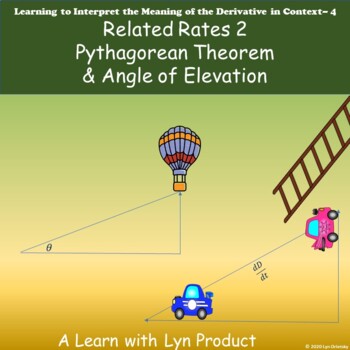
Related Rates 2: Ladders, Angles of Elevation, and the Pythagorean Theorem
In this second lesson on related rates, students will further study classic uses of this concept from falling ladders to rates of change in elevation. Related rates included in this lesson are:· A falling ladder.· Objects moving apart at right angles.· Change in the angle of elevation.· Change in size of similar triangles. The no prep lesson and worksheet are easy for students to follow and complete. You can print this lesson and use it as an in-class activity or download the digital learning
Grades:
10th - 12th
Types:
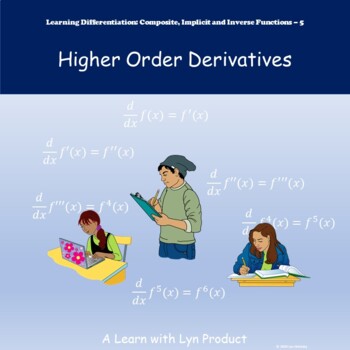
Higher Order Derivatives
If you can take a derivative once, can you take it again? Yes, you can! In this lesson, students will practice determining the second derivative of functions. Several additional concepts have been questions on previous AP exams, such as identifying derivatives of a polynomial function on a graph, and students will have an opportunity to explore these. Concepts included in this lesson are:· Second derivatives· Inductive reasoning to determine patterns in higher order derivatives.· Identifying de
Grades:
10th - 12th
Types:
Also included in: Differentiation Bundle: Composite, Implicit, and Inverse Functions
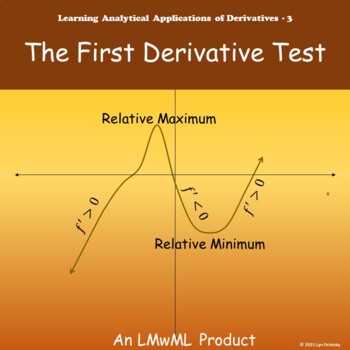
Lesson: The First Derivative Test
Students often find success with the first derivative test once they understand how to apply it. By working through the examples visually and analytically, then applying the anchor chart, students can determine where the relative extrema are located. This lesson can be used as an introduction to the first derivative test, as remediation, or as review. Concepts included in this lesson are:Determining increasing and decreasing intervals. The First Derivative Test.Relative maximum and minimum po
Grades:
11th - 12th
Types:

I Have...Who Has...Cards - U-Substitution in Integration in Calculus
The cards have been designed to be used in a class of 10, 15, 20 or 25 students. A symbol, at the bottom of the cards can be used to sort the cards. • If you use cards with a heart, the set will make one cycle with 25 cards. • If you use cards with a diamond, the set will make a cycle of 10 cards. • If you use cards with a club, the set will make a cycle of 15 cards.• If you use the cards with a spade, the set will make a cycle of 20 cards. Using the symbols you can quickly sort the cards into a
Grades:
11th - 12th, Higher Education
Types:
Also included in: Calculus - Riemann Sum and Antiderivative Bundle

Calculus - Inverse Trigonometric Differentiation Task Cards
These 36 cards are in six sets of six cards. Each of the six sets focuses on an application of using the derivative of inverse trigonometric functions.• In set 1 the students rewrite the function using the meaning of an inverse function. Then they use implicit differentiation to find dy/dx. They leave their answer as a function of y.• In set 2 the students find the slope of the tangent line to the graph of an inverse trigonometric function at a point.• In set 3 the students find the instantane
Grades:
11th - 12th, Higher Education
Types:
Also included in: Bundle of Calculus Task Cards 2
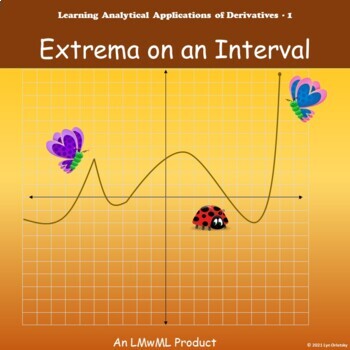
Learning Derivative Applications: Extrema on an Interval
Extrema, maximums and minimums, are used for many applications in calculus. Graphing and optimization will be the primary uses in this course. In this lesson students will explore extrema graphically and numerically. Concepts included in this lesson are:· Identifying maximums and minimums graphically. · Determining critical numbers. · Identifying the difference between absolute and local or relative extrema. · Comparing endpoints and critical numbers to determine absolute maximums and minimums.
Grades:
11th - 12th
Types:
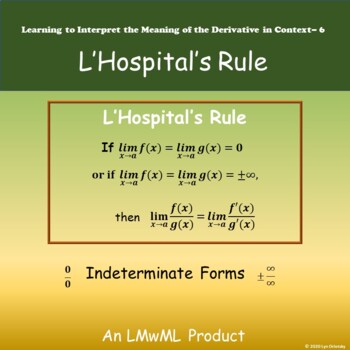
L'Hospital's Rule
Students love learning L’Hospital’s rule because it makes limits so much easier. Concepts included in this lesson are:· Identifying indeterminate forms.· Applying L’Hospital’s rule.· When L’Hospital’s rule does not apply. · Using L’Hospital’s rule more than once. The no prep lesson and worksheet are easy for students to follow and complete. You can print this lesson and use it as an in-class activity or download the digital learning choice for distance learning students. Even if you have a hyb
Grades:
10th - 12th
Types:
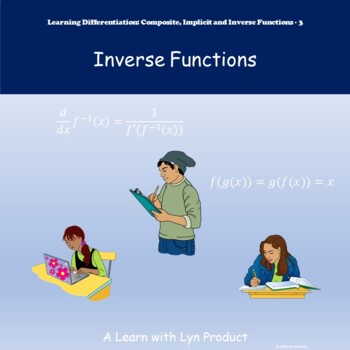
Differentiating Inverse Functions
Students should review inverse functions before they learn to take their derivatives. In this lesson students review what an inverse function is. Then using the Chain Rule, we derive the derivative of an inverse function and practice determining the inverse at a point. Although determining the derivative of an inverse function is not a heavily tested concept, an understanding of inverses and their derivatives is a foundational concept. Concepts included in this lesson are:· Review of inverse fu
Subjects:
Grades:
10th - 12th
Types:
Also included in: Differentiation Bundle: Composite, Implicit, and Inverse Functions
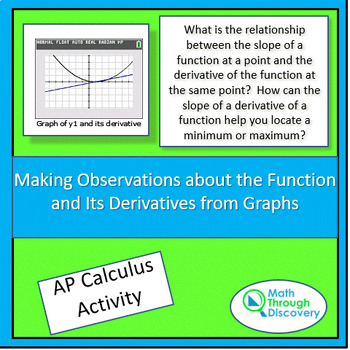
Calculus-Making Observations about the Function and Its Derivatives from Graphs
This discovery activity is made up of 5 part plus a closing question.Part I: Students graph a function and its derivative. From the two graphs students observe that when the graph of the derivative of y1 is positive the graph of y1 is increasing and that when the graph of the derivative of y1 is negative the graph of decreasing. Part II: In part I students studied a function with a minimum. In this part students will repeat the same observations but with a function that has a maximum. Part III:
Grades:
10th - 12th, Higher Education
Types:

More Derivatives: Exponentials, Logarithms, Sine, and Cosine
What is the relationship between sine and cosine, and exponentials and logarithms when determining derivatives? These functions are four more derivatives that students must commit to memory. This lesson and worksheet will guide students in applying and learning these derivatives. Concepts in this lesson are:· Comparison of derivatives of sin x and cos x.· Comparison of derivatives of natural exponent and natural log.· Evaluating derivatives.· Simplifying functions before finding derivatives
Grades:
10th - 12th
Types:
Also included in: Differentiation: Definition and Fundamental Properties

Differentiability and Continuity
How do I teach my students the relationship between continuity and differentiability? One of the best ways to teach when a function is differentiable is through graphs. Students will observe when derivatives of functions are discontinuous and therefore not differentiable at those points. Concepts in this lesson are:· The three ways a derivative fails. (Anchor chart included.)· If a function is differentiable, then it is continuous, but the converse is not always true.· The derivative of a line
Grades:
10th - 12th
Types:
Also included in: Differentiation: Definition and Fundamental Properties

Calculus - How are the Graphs of f, f ', and f " interrelated?
Using the graphing calculator, students learn how thegraphs of the first and second derivatives describe thebehavior of the original function. The activity iscomposed of four parts. Students make observationsbased upon a series of questions about increasing,decreasing, extrema, and concavity
Grades:
10th - 12th, Higher Education
Types:
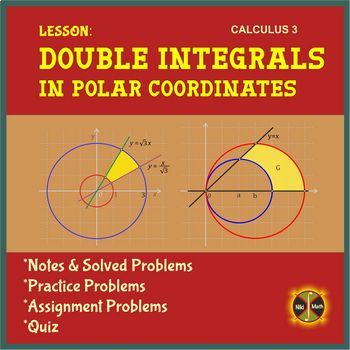
Calculus 3 / Multivariable Calculus - DOUBLE INTEGRALS in Polar Coordinates
This resource is designed for CALCULUS 3 - a comprehensive and rigorous lesson on Double Integrals in Polar Coordinates, containing 23 problems. The lesson includes◆ notes & worked out examples ( 5 problems) ◆ practice problems with hints and given answers ( 5 problems)◆ quiz ( 4 problems)◆ assignment problems ( 9 problems)All answer keys are included. ********************************************************************* ❣❣❣ PLEASE VIEW THE PREVIEW BEFORE YOU BUY: Please study the preview
Grades:
11th - 12th, Higher Education, Adult Education
Types:
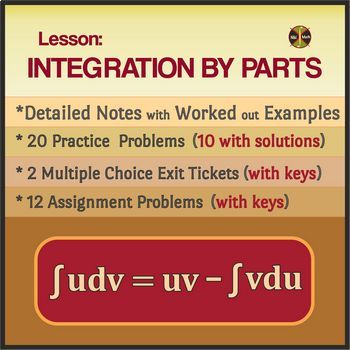
Calculus Lesson: Integration by Parts - 47 problems - Distance Learning
This is a complete rigorous lesson on Advanced Techniques of Integration for students enrolled in AP Calculus BC or Calculus 2. ( The resource contains 47 problems - 17 with full typed solutions and 30 with answer keys)Lesson Objective:Find indefinite integrals and evaluating definite integrals using integration by parts.It includesA. Detailed Guided Notes (5 pages) including derivation of Integration by Parts formula and 7 worked out examples with indefinite and definite integrals as- 4 exa
Grades:
11th - 12th, Higher Education, Adult Education
Types:

Displaced and Total Distance
AP Calculus AB and BC Course and Exam Description, Effective Fall 2019 What is the difference between total and displaced distances? The vocabulary may be new, but students have been finding displaced distance for many years. Now, they will determine total distance by applying concepts when deriving velocity from position. Concepts included in this lesson are:· Velocity is the derivative of position/distance.· Determining zero velocity.· Positive and negative velocity.· Change of dir
Grades:
10th - 12th
Types:
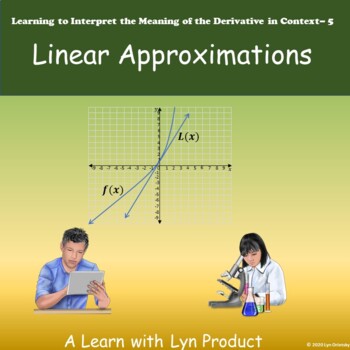
Linear Approximations
Estimating is a common skill in all math classes. Linear approximations are the primary type of estimation calculus students learn. Students will gain a solid understanding of this skill which is the basis for future advanced calculus concepts such as Newton’s Method. Concepts included in this lesson are:· Review of tangent lines.· Linear approximations. · Determining if the approximation is an overestimation or an underestimation. · Optional linear approximation for trigonometric functions. T
Grades:
10th - 12th
Types:

Equation of a Tangent Line
Some calculus rules are easy for students to learn, which gives them confidence. Using these simple rules, they will determine the equation of tangent lines. Also, a common question of the AP exam is finding derivatives from linear graphs, which is included in the lesson, the guided practice, and the worksheet. Concepts in this lesson are: · Finding slope of a tangent line. · Equation of a tangent line. · Sum, difference, and constant multiple rules. · Determining derivatives from a piecewise
Grades:
10th - 12th
Types:
Also included in: Differentiation: Definition and Fundamental Properties
Showing 1-24 of 39 results

